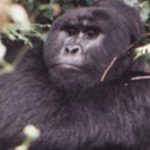Tourism based on gorilla viewing is an important strategy in the conservation of mountain gorillas in Uganda, Rwanda and the Democratic Republic of Congo. High fees are charged for such visits, generating considerable revenue for the Governments. Much has been written about the ecology and behaviour of gorillas, but an area that has received little
Impacts of Habituation for Ecotourism on the Gorillas of Nkuringo
The gorillas of Bwindi have been habituated for ecotourism in the region of Buhoma since April of 1993. The original Mubare group is still intact and continues to be visited daily by tourists. Another original group, Katendegyere, disappeared from the area and was later replaced by the large Habinyanja group, which has since fissioned (one
UWA to Begin Mock Tourism on Gorilla Groups
Uganda Wildlife Authority (UWA) is planning to start mock tourism on two newly habituated gorilla groups based in Bwinid Impenetrable National Park, in south west Uganda. This is in a bid to test their readiness to receive tourists. Habituation of the gorillas began in 2006, and for the last two years trackers have followed them
Rushegura Gorilla Family Members Named
What a great innovation! Uganda Wildlife Authority staff in Bwindi Impenetrable National Park, Uganda’s most popular national park, have been able to give names to all eleven gorillas in the Rushegura group. Thumbs up our Bwindi staff!! This is no mean achievement. The process involves closely observing the gorillas for endless hours. No easy task
Bwindi Communities Benefit from Gorilla Tourism
When gorilla tourism was introduced in the Bwindi Impenetrable Forest ten years ago, there were many sad faces among the communities neighboring the newly created national park. They had just said goodbye to lots of free honey, wood, and even gold, which they used to dig manually. But the sadness lasted for a very short
Gorilla Permits Increase to 32
The number of permits available for visitors trekking in Bwindi had been increased to 32 after the a split of the Habinyanja group in 2002 allowing for the tracking of what is now ‘Habinyanja ‘ and ‘Rushegura’ groups and the introduction of the Nkuringo group in September 2004. Below is a breakdown of the composition
An Outbreak of Mange Hits the Bwindi Gorillas
In July 2000, the Mountain Gorilla Veterinary Project (MGVP) received an urgent call that 3 juveniles of the Nkuringo group on the edge of the Bwindi National Park were losing hair and one was lethargic and not eating. The problem sounded like it was probably the skin parasite Sarcoptes, commonly called mange or scabies. There
Scabies in Bwindi
At the end of July, the Ugandan park authorities asked the Mountain Gorilla Veterinary Center to examine the gorillas in the Nkuringo group that is currently being habituated. The animals had lost hair and scratched themselves more than usual. Three young animals had an abnormal skin condition. One gorilla was anaesthetized, as it had lost


New Gorilla Census in Bwindi
A team of scientists has found that nearly 300 gorillas are still living in the Bwindi Impenetrable National Park. A similar number (290-310) had also been found during the period of 1987 to 1993 when all groups were identified and monitored by Thomas Butynski and his team. The new census, conducted in October and November
Case Report on Scabies Infection in Bwindi Gorillas
Uganda Wildlife Authority (UWA) and the International Gorilla Conservation Programme (IGCP) have been working together to treat a skin disease in one of the gorilla groups in Bwindi Impenetrable National Park. This case has involved both veterinarians and park managers in the attempt to decipher the cause of the problem and to treat it, while




